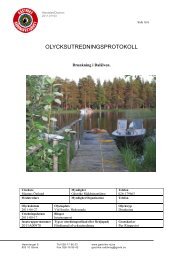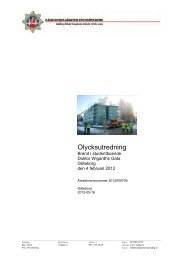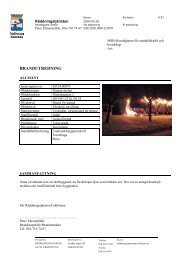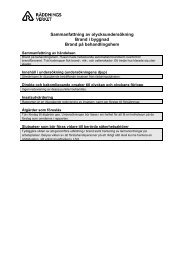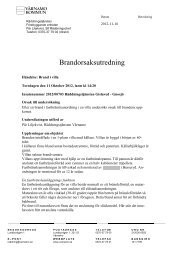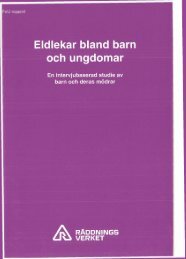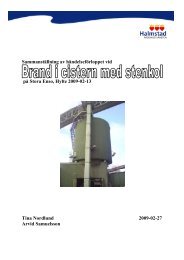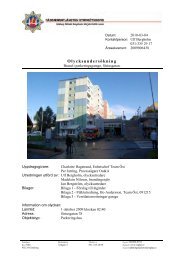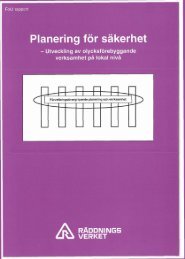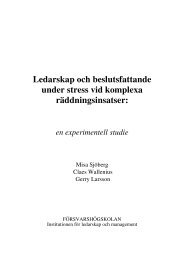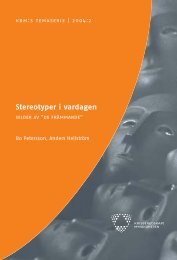Create successful ePaper yourself
Turn your PDF publications into a flip-book with our unique Google optimized e-Paper software.
TV news programme Aktuellt (on<br />
SVT) devoted most time to the event.<br />
Secondly, shortly after the murder,<br />
a critical debate was launched on media<br />
reporting that singled out a succession<br />
of individuals as the suspected perpetrator.<br />
The publication of photos and<br />
personal details about a 35-year-old<br />
male suspect was severely criticized.<br />
A questionnaire in Dagens Nyheter’s<br />
online edition on 22 September 2003<br />
showed how three quarters of those<br />
who responded thought that coverage<br />
of the murder was either poor or bad.<br />
Journalists, the general public, columnists<br />
and researchers took part in the<br />
debate that took place in the news,<br />
editorials, op-eds, radio and television<br />
programmes.<br />
Thirdly, the Anna Lindh murder<br />
and investigation that followed were<br />
immediately linked to the unsolved<br />
murder of Prime Minister Olof Palme<br />
in 1986. In Ekot’s broadcast at 17.45<br />
on 10 September – approximately one<br />
and a half hours after the stabbing –<br />
political commentator Inger Arenander<br />
drew similarities between both events,<br />
and the murders were compared several<br />
times during reports on SVT and TV4<br />
that evening. Editorials in major Stockholm<br />
newspapers the next day also<br />
drew a parallel between the two events.<br />
The media interpreted, analysed and<br />
tried to explain Anna Lindh’s murder<br />
against the background of events in<br />
1986. Headings like 17 years – and still<br />
no killer. New bloodstains, new roses but<br />
the same icy silence (Expressen 12/9),<br />
Have we learnt nothing (Dagens Nyheter<br />
12/9), and Cruel proof of flawed<br />
system (Svenska Dagbladet 12/9) set the<br />
interpretative framework that would<br />
underlie media reporting. Expectations<br />
that the killer would be found, on<br />
how the police and prosecutors would<br />
handle the investigation and on the<br />
final burden of proof were set against<br />
the failure to find and convict Palme’s<br />
killer. The interpretative framework was<br />
summarised by two words: Not again!<br />
and established early in the afternoon<br />
of 10 September by Social Democratic<br />
politicians and media analysts.<br />
There are several other similarities<br />
between the shooting of Olof Palme<br />
in February, 1986 and the stabbing of<br />
Anna Lindh in September, 2003. At<br />
the time of their deaths, both were toplevel<br />
politicians with long experience in<br />
the Swedish Social Democratic movement.<br />
Both were well known outside of<br />
Sweden because of their international<br />
assignments. The motive for both<br />
murders was speculated as political;<br />
in the Palme case because of his international<br />
profile, in the Lindh case<br />
because of her leading role in the EMU<br />
referendum campaign. Both murders<br />
were perceived as attacks on Swedish<br />
democracy and openness. Both Palme<br />
and Lindh were murdered in central<br />
Stockholm, and neither of them had<br />
bodyguards. The initial suspects were<br />
later eliminated from both investigations;<br />
in the Palme case, a 33-year-old<br />
male and in the Lindh case, a 35-yearold<br />
male. And both times, charges<br />
were finally brought against people<br />
described as addicts and mentally<br />
a classic criminal drama | 133




